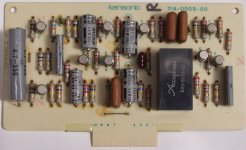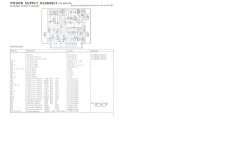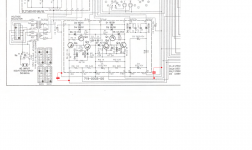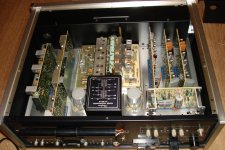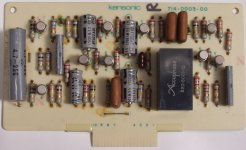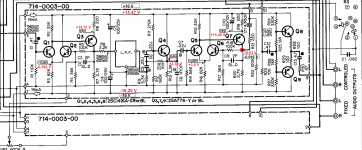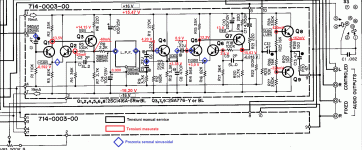Hi again, as I have the intention to keep that tuner (it sounds lovely even like that) there is no problem for me making some changings inside which may or may not lower the look in case of eventual reselling.The thing is that it's still a good solid piece..it just needs a little help being all it can be. Sounds like you've run it enough to know how it behaves and if there's anything wrong or working poorly. That's a start. The next step is to figure out how far you may want to go with any work that you do...anywhere from just straight parts replacement to all out modification. This is very much like any collectible item..especially cars. How much do you want to keep as original? If you intend to hang on to this tuner, you may not be as concerned with resale value...and maybe a little more interested in going further with the work you do that could help take it through the last 5% or 10% of sound quality. Oh yeah...good deal on joining the FMTuner board. If there's anywhere on the internet that you can find people who are knowledgeable with that item, that's the place.
Same effect. No engineer in his right mind would drop 2 filter caps from a high quality power supply unless directed by another person.
But only the engineer can do that. He may have been told to save twenty bucks per unit, but certainly not which components to drop.
An engineer's job is to balance the key factors involved in bringing a product to market including quality, cost, size, mass, manufacturability, etc. If the logic that "No engineer in his right mind would drop two filter caps..." were true then engineered devices would be oversized, too costly and unoptimized.
The key to resolving these engineering tradeoffs are the technical specifications and cost targets that the engineer is tasked to meet. If the second set of filter caps merely shaves a fraction of a dB off noise performance already greatly exceeding the specification target then the engineer would be derelict of duty to leave them in, because the cost of those caps could achieve better performance applied elsewhere. Alternatively after a device is in production there is a need to maintain product balance. Increased labor costs might shave the margin on a product such that it was no longer profitable to produce. If a listener can't distinguish the two cap version from the four cap then the two removed caps are a waste of money and space.
Profitability is, at the end of the day the reason a company exists and the only outcome that sustains its products in the market. The "bean counter" mentality as the only guiding principle can be destructive but letting audiophilia nervosa become the unconstrained engineering mantra of an audio business would surely send it into bankruptcy.
The key to resolving these engineering tradeoffs are the technical specifications and cost targets that the engineer is tasked to meet. If the second set of filter caps merely shaves a fraction of a dB off noise performance already greatly exceeding the specification target then the engineer would be derelict of duty to leave them in, because the cost of those caps could achieve better performance applied elsewhere. Alternatively after a device is in production there is a need to maintain product balance. Increased labor costs might shave the margin on a product such that it was no longer profitable to produce. If a listener can't distinguish the two cap version from the four cap then the two removed caps are a waste of money and space.
Profitability is, at the end of the day the reason a company exists and the only outcome that sustains its products in the market. The "bean counter" mentality as the only guiding principle can be destructive but letting audiophilia nervosa become the unconstrained engineering mantra of an audio business would surely send it into bankruptcy.
The Accuphase T 100 was meant to be a statement item. The engineers had just broken away from Kenwood and probably wanted to show off a bit and throw a little sand in Kenwood's face. So a little extra sauce in the design was probably called for. They weren't looking at profitability so much at first as getting some notice among reviewers. "The key to resolving these engineering tradeoffs are the technical specifications and cost targets that the engineer is tasked to meet. If the second set of filter caps merely shaves a fraction of a dB off noise performance already greatly exceeding the specification target then the engineer would be derelict of duty to leave them in, because the cost of those caps could achieve better performance applied elsewhere. Alternatively after a device is in production there is a need to maintain product balance. Increased labor costs might shave the margin on a product such that it was no longer profitable to produce. If a listener can't distinguish the two cap version from the four cap then the two removed caps are a waste of money and space."...These are 80's and 90's values...not so much in the 70's.
...These are 80's and 90's values...not so much in the 70's.
So the need for a product to sell at less than the cost to produce it and to do so by avoiding content that drives up the price without improving performance originated in the 1980s and 90s? Huh, so I must have been imagining that these issues were emphasized in the first decade of my engineering career. I think you'll need to go back to the early days of engineering mass produced goods. Oh but I forgot, audio is different!
The problem now Kevin on another website of UK origin I answered angry responses from UK citizens on the low grade- third world type of selling to the UK resulting in domestic equipment breaking down constantly as well as entertainment equipment .
As I act like an investigative journalist I studied their claims and many turned out be linked to the importers ,not just in the the UK but USA as well.
Both countries bought imported goods originating in China which I know ---"builds to a price " .
I bought 3 varieties of a soldering station ALL had the same outer shell but the cheap one had very poor quality parts inside while the dearer one ( nearly 3 times the price ) had higher quality parts.
On investigation on Chinese markets and Chinese government policy it turned out Chinese law puts the onus on those exporters as to the reliability of the products made internally not on the actual Chinese manufacturing company .
As a result high profit driven entities sold low quality goods either direct or through businesses based in both countries (UK/USA ).
The excuse ?---the public want cheap--- not what the 1000,s of UK citizens posted - "this product packed up after xx months " was typical but as the UK citizens found out you cant sue the Chinese as China has a policy of not allowing faulty goods to be imported back to China.
Deal with the importers/shop they are told .
I have a lot more on this but its relevant to modern manufacturing policy --many EU labelled goods are actually Chinese but I don't blame the Chinese as--- they build to a price .
As I act like an investigative journalist I studied their claims and many turned out be linked to the importers ,not just in the the UK but USA as well.
Both countries bought imported goods originating in China which I know ---"builds to a price " .
I bought 3 varieties of a soldering station ALL had the same outer shell but the cheap one had very poor quality parts inside while the dearer one ( nearly 3 times the price ) had higher quality parts.
On investigation on Chinese markets and Chinese government policy it turned out Chinese law puts the onus on those exporters as to the reliability of the products made internally not on the actual Chinese manufacturing company .
As a result high profit driven entities sold low quality goods either direct or through businesses based in both countries (UK/USA ).
The excuse ?---the public want cheap--- not what the 1000,s of UK citizens posted - "this product packed up after xx months " was typical but as the UK citizens found out you cant sue the Chinese as China has a policy of not allowing faulty goods to be imported back to China.
Deal with the importers/shop they are told .
I have a lot more on this but its relevant to modern manufacturing policy --many EU labelled goods are actually Chinese but I don't blame the Chinese as--- they build to a price .
As this tuner has nice reviews on lots of sites, my expectations are great.
having completed the list and the order for the axial capacitors (all from Vischay/BC) and the PSU from Kemmit/BHC, I said is time to make some listening test the way it is.
I realise that sound is excessive bright but detailed. Unfortunately bass is far away from what I was expected, compared with my Thandberg 3001, Leak TL3 and Quad FM3.
Reception is very good and noise is very low. Testing the switches on the hidden panel I realise they are hard to rotate and the worst, the MPX noise switch on OFF is cutting down the R channel. Till now I was not able to follow the schematics and understand where is the problem.
having completed the list and the order for the axial capacitors (all from Vischay/BC) and the PSU from Kemmit/BHC, I said is time to make some listening test the way it is.
I realise that sound is excessive bright but detailed. Unfortunately bass is far away from what I was expected, compared with my Thandberg 3001, Leak TL3 and Quad FM3.
Reception is very good and noise is very low. Testing the switches on the hidden panel I realise they are hard to rotate and the worst, the MPX noise switch on OFF is cutting down the R channel. Till now I was not able to follow the schematics and understand where is the problem.
Hi guys,
This afternoon, I've started checking for the absence of output on the Right channel. The bad news is that the right channel amplifier is not working. Let say the good news is the buffer is ok but the rest of the amplifier does not work. Also, the good news is that the decoder works as signal left and right is present until the input of the amplifier boards.
As the position in place is quite difficult to manage for measuring tensions or injecting signal and tracing it. I had to stop and think about making an adaptor for the connector and keep the board out of the chassis somehow.
To tell you the truce, I don't know where to start and where to do the measurements.
I also checked visually the board and the soldering points and seams to be ok from this point of view.
Any help, any idea?
This afternoon, I've started checking for the absence of output on the Right channel. The bad news is that the right channel amplifier is not working. Let say the good news is the buffer is ok but the rest of the amplifier does not work. Also, the good news is that the decoder works as signal left and right is present until the input of the amplifier boards.
As the position in place is quite difficult to manage for measuring tensions or injecting signal and tracing it. I had to stop and think about making an adaptor for the connector and keep the board out of the chassis somehow.
To tell you the truce, I don't know where to start and where to do the measurements.
I also checked visually the board and the soldering points and seams to be ok from this point of view.
Any help, any idea?
Hi,
Today I checked visually the board and the soldering points and seams to be ok from this point of view.
Then I have measured the static voltages according to the service manual and the results are as follows:
U+=+15,47V instead of +16V
U-=-16,2V instead of -16V
Emitor Q1 = -0,592V instead of -0,6V
Emitor Q3 = +14,15 instead of +14V
Emitor Q4 = +3,38V instead of +3,4V
Emitor Q5/Q6 = +3V instead of -0,6V
Emitor Q7 = +15,5V instead od +14V
Collector Q7 = -15,63V instead of -0,016V measured on the Left board which is working.
I suppose Q5/Q6/Q7 are gone, but why?. This is the effect but where can be the cause?
I have unsoldered Q5/Q6?Q7 (2SC1746/2SC1746/2SA856)
I had measured the junction b-c/b-e and values are about 0,720-0,760 V
I checked all adjacent components, the resistors, as well as capacitors values, are OK.
Unfortunately, there is impossible to find the original transistors so I shall try the European equivalents BC 416 and BC 414. I hope they are ok.
Anny idea from an experimented guy?
Today I checked visually the board and the soldering points and seams to be ok from this point of view.
Then I have measured the static voltages according to the service manual and the results are as follows:
U+=+15,47V instead of +16V
U-=-16,2V instead of -16V
Emitor Q1 = -0,592V instead of -0,6V
Emitor Q3 = +14,15 instead of +14V
Emitor Q4 = +3,38V instead of +3,4V
Emitor Q5/Q6 = +3V instead of -0,6V
Emitor Q7 = +15,5V instead od +14V
Collector Q7 = -15,63V instead of -0,016V measured on the Left board which is working.
I suppose Q5/Q6/Q7 are gone, but why?. This is the effect but where can be the cause?
I have unsoldered Q5/Q6?Q7 (2SC1746/2SC1746/2SA856)
I had measured the junction b-c/b-e and values are about 0,720-0,760 V
I checked all adjacent components, the resistors, as well as capacitors values, are OK.
Unfortunately, there is impossible to find the original transistors so I shall try the European equivalents BC 416 and BC 414. I hope they are ok.
Anny idea from an experimented guy?
Attachments
Last edited:
I had already unsoldered the Q5/6/7 so I was thinking is easier to check them out of the circuit. But now I am a little bit confused as I don't know how to measure.Voltage at base of Q5 and Q6 ? Q7 may be dead.
Right, I'll do it. Thanks for encouraging me.Based on your voltages Q7 is not conducting.
For the moment replace Q7 only, any small pnp will do.
Have a look at the pin layout however.
I managed to make time with the measurements, I attach the results obtained on the defective board.
I completed all the static measurements with the points mentioned by colleagues (bases and others)
I disconnected C1 and introduced 1Khz sinusoidal signal and watched as far as the signal appears, respectively in the emitters Q5 and Q6 but it does not go further. I disconnected the C10 and nothing happened, I replaced the Q7 with a BC416 and nothing happened.
I've been able to get this far.
I completed all the static measurements with the points mentioned by colleagues (bases and others)
I disconnected C1 and introduced 1Khz sinusoidal signal and watched as far as the signal appears, respectively in the emitters Q5 and Q6 but it does not go further. I disconnected the C10 and nothing happened, I replaced the Q7 with a BC416 and nothing happened.
I've been able to get this far.
Attachments
In fact, while measuring the functional board (left channel) base of Q5 was -20mV, base of Q6 was +14mV , collector Q7 was -16mV and base Q7 was +13,5VAt base of Q5 zero dc volts are to be expected. Remove Q5.
Hi,
I had just replaced the Q5 & Q6 with a well-matched (407beta) pair of BC414B. Immediately the audio module was awake to life and the static measurements went similar to the other channel module. The sound was not so bad, but I admit that placebo phenomena can cure.
Now I can make the full list of modern components to be replaced and I hope to get in the end a nice-sounding tuner.
I had just replaced the Q5 & Q6 with a well-matched (407beta) pair of BC414B. Immediately the audio module was awake to life and the static measurements went similar to the other channel module. The sound was not so bad, but I admit that placebo phenomena can cure.
Now I can make the full list of modern components to be replaced and I hope to get in the end a nice-sounding tuner.
- Status
- This old topic is closed. If you want to reopen this topic, contact a moderator using the "Report Post" button.
- Home
- Source & Line
- Analogue Source
- My Accuphase T 100
